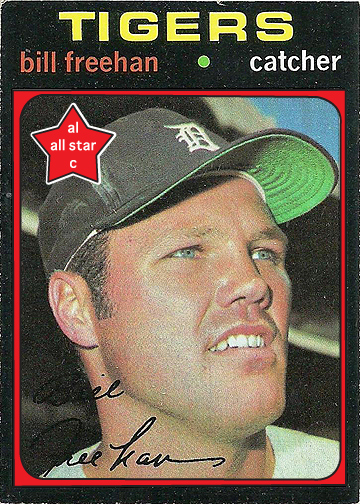The 1950's had all-time catchers like Roy Campanella and Yogi Berra, and the 1970's had superstars like Carlton Fisk and Johnny Bench, but in the decade of the 1960's, there weren't any "all-time" catchers that could really keep company with the guys I mentioned earlier.
But it's not to say there weren't any good catchers.
For my "all-decade" team, my two backstops are the Tigers' Bill Freehan and the Braves Joe Torre.
Take a look at my card:
It's safe to say that between Berra and Fisk, Freehan was easily the best catcher in the American League.
With all the superstars on the filed during the decade, it's easy to forget that Freehan was an eleven-time all-star, five-time Gold Glover, and finished in the top-ten in M.V.P. voting three times, with a second place finish in 1968 behind teammate Denny McLain.
1964, his first full year in the Majors, was arguably his finest season, as he hit .300 for the only time in his career along with 18 homers and 80 R.B.I.'s.
But for the rest of the decade Freehan put up comparable numbers year after year, while taking are of a Detroit pitching staff that featured guys like McLain, Mickey Lolich and Earl Wilson.
He really was ahead of the rest of the pack as far as A.L. catchers during the decade.
Over in the National League, some of you may be surprised at my pick of Joe Torre as the catcher of the decade, but take a look at the guy's numbers and you'll see why.
With a decade that didn't have that Campanella or Bench behind the plate, Torre outdistances other catchers in the league in my opinion.
A five-time all-star during the '60's, Torre had a couple of "monster" years that kind of get lost in history.
In 1964 playing for the Milwaukee Braves, Torre hit .321 with 20 homers and 109 runs batted in. He also chipped in 193 hits and 36 doubles. Not bad!
But in 1966, with the Braves relocated to Atlanta, Torre clubbed 36 home runs to go along with a .315 average and 101 R.B.I.'s.
Later on when he'd switch over to third base he'd win an M.V.P. with the St. Louis Cardinals, and tack on a few more excellent years at the plate, and it's those years that people generally remember Torre as a player.
But his catching days for the Braves organization were very good in their own right. yet easy to overlook.
Later on, as we all know, Torre would be inducted into the Hall of Fame as a manager in 2014 for his days leading the New York Yankees through their most recent dynasty in the late-90's/early-00's, along with taking the helm of the Mets, Braves, Cardinals and Dodgers as well between 1977 and 2010, finishing up with 2326 wins and four championship titles.
Next up on the all-decade parade, the first outfield slot, with a couple of future Hall of Famers: Carl Yastrzemski and Hank Aaron.































